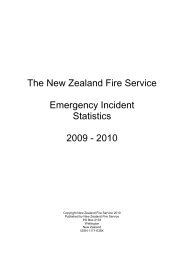A guide to the New Zealand Fire Service Levy
A guide to the New Zealand Fire Service Levy
A guide to the New Zealand Fire Service Levy
You also want an ePaper? Increase the reach of your titles
YUMPU automatically turns print PDFs into web optimized ePapers that Google loves.
<strong>Levy</strong> payable on all o<strong>the</strong>r assets<br />
<strong>Levy</strong> is payable on all assets insured against <strong>the</strong> risk of fire. Assets are not limited <strong>to</strong> buildings and include<br />
s<strong>to</strong>ck, plant and equipment and anything else insured against <strong>the</strong> risk of fire. The Third Schedule of <strong>the</strong> <strong>Fire</strong><br />
<strong>Service</strong> Act contains a list of items that are exempt from levy.<br />
Where an item is not exempt and is not subject <strong>to</strong> limits, levy is payable at <strong>the</strong> rate of 7.6 cents per $100 of<br />
assets insured. The value of assets insured is generally calculated using <strong>the</strong> sum insured, but where<br />
settlement of <strong>the</strong> claim is no more favourable than <strong>the</strong> sum insured, it can also be calculated on <strong>the</strong><br />
indemnity value of <strong>the</strong> assets covered by <strong>the</strong> policy.<br />
The indemnity inflation fac<strong>to</strong>r is deemed <strong>to</strong> be part of <strong>the</strong> indemnity value. So, whenever inflation is insured<br />
in an indemnity value contract of fire insurance <strong>the</strong> levy is deemed payable (less <strong>the</strong> same discount up <strong>to</strong> a<br />
maximum of 50%) that <strong>the</strong> insurer has applied in determining <strong>the</strong> premium rating for <strong>the</strong> contract of<br />
insurance.<br />
Calculating <strong>Fire</strong> <strong>Service</strong> <strong>Levy</strong><br />
This simple table is designed <strong>to</strong> help you think about <strong>the</strong> issues that are involved with <strong>the</strong> calculation of levy:<br />
Sum insured under <strong>the</strong> contract<br />
(or indemnity value of assets plus any applicable inflation)<br />
Less<br />
Items exempt from levy<br />
Items subject <strong>to</strong> limits<br />
Primary levy liability<br />
Add levy on items subject <strong>to</strong> limits<br />
Residential buildings<br />
Personal property<br />
Mo<strong>to</strong>r vehicles<br />
<strong>Levy</strong> on assets<br />
Add levy on limits and extensions<br />
Contract works<br />
Capital additions<br />
Annual levy liability<br />
Multiply by period of cover<br />
<strong>Levy</strong> payable<br />
Add GST (currently 15%)<br />
Total amount payable <strong>to</strong> <strong>the</strong> NZFS Commission<br />
<strong>Levy</strong> Interest and Surcharge<br />
If a payment is late, interest may be charged at 1.5% per month, or pro rata for each part month <strong>the</strong> levy is<br />
late. If <strong>the</strong> levy payment is over 6 months late, a surcharge of 10% plus GST must be added <strong>to</strong> <strong>the</strong><br />
outstanding levy. This surcharge is charged for every period of six months that <strong>the</strong> levy payment is late. The<br />
surcharge will continue <strong>to</strong> accrue on any unpaid amount (excluding interest) until <strong>the</strong> outstanding levy has<br />
been paid.<br />
Interest and surcharges are calculated on <strong>the</strong> GST-inclusive value of <strong>the</strong> outstanding/late levy value. Any<br />
payments that are received after <strong>the</strong> 15 th of <strong>the</strong> month are deemed late under <strong>the</strong> Act.<br />
When a levy payment has been identified as being late or a shortfall has been identified, an invoice will be<br />
issued for any levy arrears, interest, surcharge and GST where applicable.<br />
<strong>Levy</strong> Manual for Direct Payers 7
















